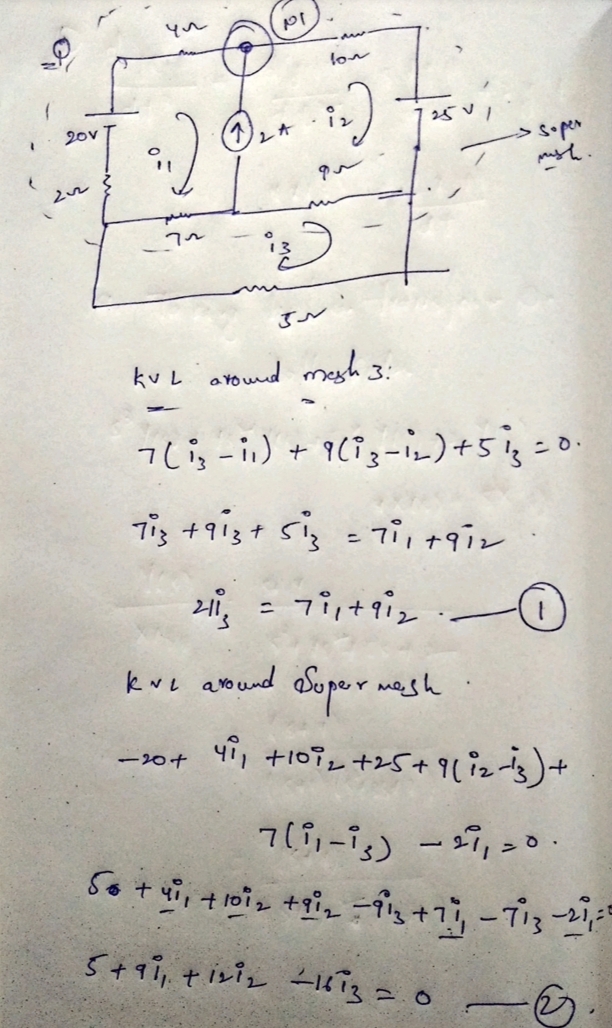2. 3. Using the node voltage method, find the voltage at the essential nodes in the circuit below. 251( 20v ww 3. as} 2.5 LJ In Label the mesh currents in the circuit below, and write the equations for the mesh currents. do not solve the equations, just write them! Oas v a um 75 www 4.2 7.5 102 SA 5.5 2A 55L in 75 65 Find the Norton equivalent circuit for terminals a + b in the circuit below by using source transformation. 95 3A m 35 IDV
2. 3. Using the node voltage method, find the voltage at the essential nodes in the circuit below. 251( 20v ww 3. as} 2.5 LJ In Label the mesh currents in the circuit below, and write the equations for the mesh currents. do not solve the equations, just write them! Oas v a um 75 www 4.2 7.5 102 SA 5.5 2A 55L in 75 65 Find the Norton equivalent circuit for terminals a + b in the circuit below by using source transformation. 95 3A m 35 IDV
Introductory Circuit Analysis (13th Edition)
13th Edition
ISBN:9780133923605
Author:Robert L. Boylestad
Publisher:Robert L. Boylestad
Chapter1: Introduction
Section: Chapter Questions
Problem 1P: Visit your local library (at school or home) and describe the extent to which it provides literature...
Related questions
Question
100%
2 only please

Transcribed Image Text:**Educational Circuit Analysis Problems:**
Welcome to the circuit analysis section. Below are a few circuit problems to help you practice your electrical engineering skills.
1. **Node Voltage Method Problem:**
- **Task:** Using the node voltage method, find the voltage at the essential nodes in the circuit below.
- **Circuit Description:**
- A circuit with a 25V voltage source is connected to resistors with values 3Ω, 2.5Ω, 10Ω, and 5Ω, and a current source of 3A. The resistors and sources form a network with essential nodes to analyze.
2. **Mesh Current Method Problem:**
- **Task:** Label the mesh currents in the circuit below, and write the equations for the mesh currents. Do not solve the equations, just write them.
- **Circuit Description:**
- The circuit includes a 20V voltage source, a 30V voltage source, and a 2.5V voltage source, arranged with resistors of 4Ω, 7Ω, 6Ω, 3Ω, and 9Ω. The circuit forms multiple loops (meshes) for analysis.
3. **Norton Equivalent Circuit Problem:**
- **Task:** Find the Norton equivalent circuit for terminals a + b in the circuit below by using source transformation.
- **Circuit Description:**
- It includes a 5A current source in parallel with a 5Ω resistor, and a series connection of a 3Ω resistor and a 10V voltage source. The goal is to simplify this circuit to its Norton equivalent between terminals a and b.
**Diagrams Explained:**
- Each problem includes a detailed circuit diagram with components clearly labeled, including voltage and current sources as well as resistors.
- Nodes, meshes, and terminals are indicated where necessary for problem-solving.
These problems provide a practical learning experience in applying the node voltage method, the mesh current method, and source transformations to find equivalent circuits.
Expert Solution
Step 1

Step by step
Solved in 2 steps with 2 images

Knowledge Booster
Learn more about
Need a deep-dive on the concept behind this application? Look no further. Learn more about this topic, electrical-engineering and related others by exploring similar questions and additional content below.Recommended textbooks for you

Introductory Circuit Analysis (13th Edition)
Electrical Engineering
ISBN:
9780133923605
Author:
Robert L. Boylestad
Publisher:
PEARSON

Delmar's Standard Textbook Of Electricity
Electrical Engineering
ISBN:
9781337900348
Author:
Stephen L. Herman
Publisher:
Cengage Learning

Programmable Logic Controllers
Electrical Engineering
ISBN:
9780073373843
Author:
Frank D. Petruzella
Publisher:
McGraw-Hill Education

Introductory Circuit Analysis (13th Edition)
Electrical Engineering
ISBN:
9780133923605
Author:
Robert L. Boylestad
Publisher:
PEARSON

Delmar's Standard Textbook Of Electricity
Electrical Engineering
ISBN:
9781337900348
Author:
Stephen L. Herman
Publisher:
Cengage Learning

Programmable Logic Controllers
Electrical Engineering
ISBN:
9780073373843
Author:
Frank D. Petruzella
Publisher:
McGraw-Hill Education

Fundamentals of Electric Circuits
Electrical Engineering
ISBN:
9780078028229
Author:
Charles K Alexander, Matthew Sadiku
Publisher:
McGraw-Hill Education

Electric Circuits. (11th Edition)
Electrical Engineering
ISBN:
9780134746968
Author:
James W. Nilsson, Susan Riedel
Publisher:
PEARSON

Engineering Electromagnetics
Electrical Engineering
ISBN:
9780078028151
Author:
Hayt, William H. (william Hart), Jr, BUCK, John A.
Publisher:
Mcgraw-hill Education,